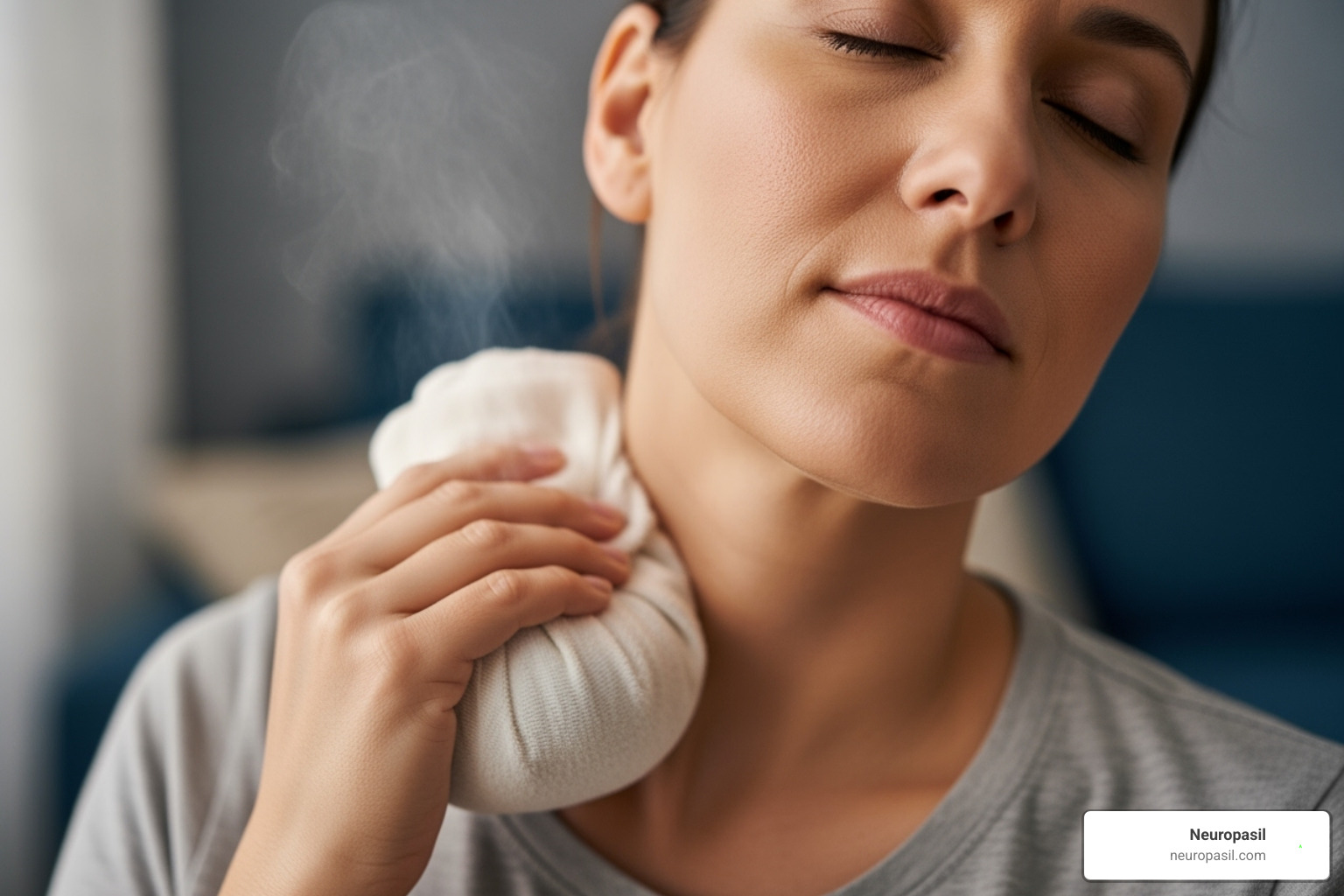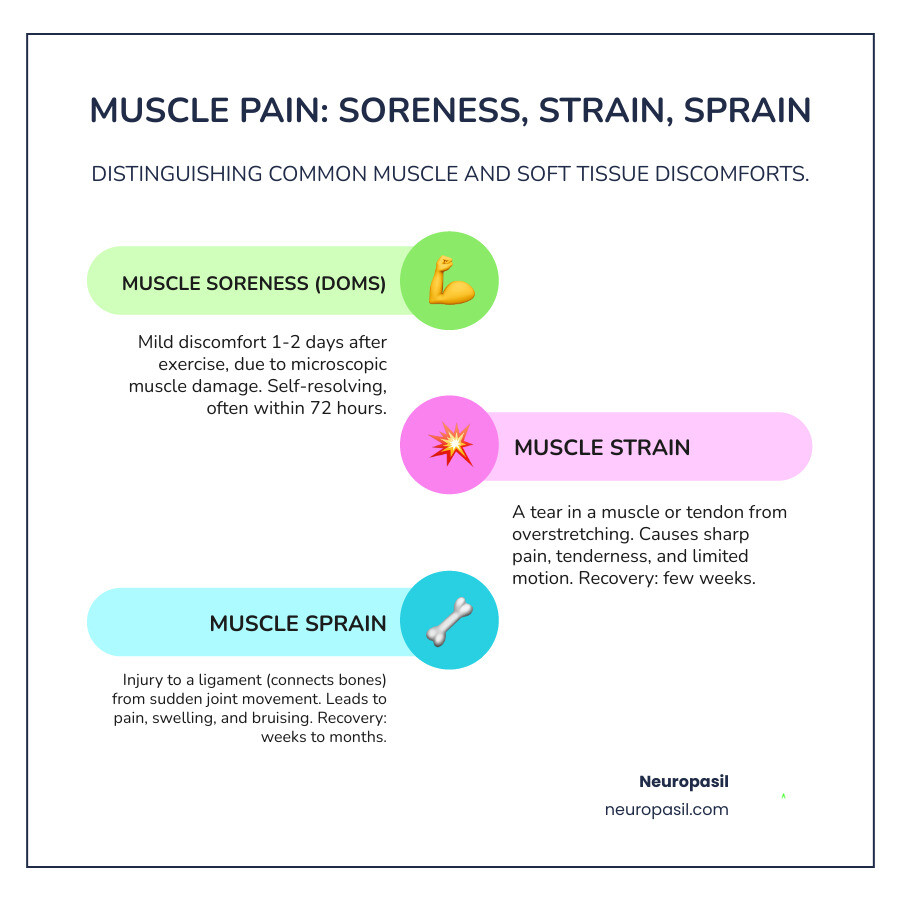Why Muscle Pain Relief Matters in Your Daily Life

Muscle pain relief is something we all need, whether from a tough workout, an awkward sleeping position, or daily desk strain. Post-activity soreness is a near-universal experience.
Quick muscle pain relief options:
- Rest and gentle movement to help blood flow
- Heat therapy for muscle relaxation
- Cold therapy for recent injuries and inflammation
- Topical treatments for targeted relief
- Over-the-counter medications for general pain
- Gentle stretching to prevent stiffness
Myalgia (the medical term for muscle pain) can range from mild soreness to chronic conditions. While up to 60 percent of older adults live with persistent muscle pain, people of all ages experience it. Understanding whether your pain is normal soreness or something more serious is key to choosing the right treatment. Most muscle pain stems from overuse, stress, or minor injuries and responds well to simple home remedies.

Understanding Muscle Pain: Causes and Symptoms
Muscle pain relief begins with understanding its cause. Myalgia—the medical term for muscle pain—affects our muscles, ligaments, tendons, and connecting soft tissue. Most cases are temporary, but sometimes the pain signals a deeper issue.
Overexertion and delayed onset muscle soreness (DOMS) is the most common culprit. It appears 12 to 48 hours after intense activity creates tiny microscopic tears in muscle fibers. This is a normal part of building stronger muscle. Light movement can speed up recovery by improving blood flow. Scientific research on DOMS confirms this is a normal part of muscle adaptation.
Injuries like strains and sprains are more direct causes. A strain is a torn muscle, while a sprain affects ligaments around a joint. Both cause immediate pain and require proper care.
Stress and tension can cause muscles in the neck, shoulders, and back to tighten into knots.
Dehydration and nutritional deficits, such as a lack of vitamin D or electrolytes, can turn normal fatigue into prolonged soreness and cramping.
Infections like the flu often cause widespread body aches as your immune system works overtime.
Sometimes, muscle pain signals underlying medical conditions. Fibromyalgia causes widespread pain and fatigue, while arthritis can lead to secondary muscle pain as muscles work harder to support sore joints. Certain medications, like statins, can also cause muscle pain. For more insights, check this resource: More info about physical activity for aches.
Common Symptoms of Muscle Aches
Your muscles communicate discomfort in several ways. You might feel a dull ache or a sharp pain. Pain can be localized to one spot or widespread throughout the body. Other common symptoms include:
- Muscle stiffness, especially after rest.
- Limited range of motion, making simple movements difficult.
- Swelling and redness, indicating inflammation.
- Weakness in the affected muscles.
Symptoms That Require Medical Attention
While most muscle pain is manageable at home, some symptoms require a doctor's evaluation.

Seek professional help if you experience severe pain, trouble breathing, a high fever with a stiff neck, or signs of infection like redness and swelling. It's also important to see a doctor for pain that persists for over a week, is accompanied by a rash (especially after a tick bite), or starts after taking a new medication. For a detailed guide, the Mayo Clinic provides excellent information: When to see a doctor for muscle pain. Always trust your instincts and consult a healthcare professional if you're concerned.
Effective Strategies for At-Home Muscle Pain Relief
The good news is that most common muscle aches respond well to simple at-home care. Having a toolkit of muscle pain relief methods can help you manage post-workout soreness or tension from a long day. These remedies offer both immediate relief and long-term management. For exercise-related soreness, our guide on how to Reduce Muscle Soreness After Workout is particularly helpful.
The R.I.C.E. Method for Acute Injuries
For a recent pull or twist, the R.I.C.E. method is your go-to strategy for managing acute injuries.

- Rest: Give the injured muscle a break. "Relative rest" (avoiding painful activities while allowing gentle movement) is often best.
- Ice: Apply an ice pack wrapped in a cloth for 15-20 minutes at a time during the first 24-48 hours to reduce inflammation and numb pain.
- Compression: Use an elastic bandage to minimize swelling, ensuring it's not so tight that it cuts off circulation.
- Elevation: Prop the injured limb above heart level to help drain fluid and reduce swelling.
The R.I.C.E. method is highly effective in the first hours after an injury. Learn more from this resource: The R.I.C.E method explained.
Heat and Cold Therapy
Knowing whether to use heat or cold can make a huge difference. They work in opposite ways and are suited for different problems.
| Feature | Cold Therapy | Heat Therapy |
|---|---|---|
| When to Use | Recent injuries (first 24-48 hours), acute or throbbing pain, swelling, inflammation. | Older injuries, chronic pain, stiffness, muscle tension, before stretching. |
| Benefits | Reduces inflammation and swelling, numbs pain, slows blood flow. | Increases blood flow, relaxes muscles, soothes stiffness, promotes healing. |
| Application | Ice packs, cold compresses, or cold baths for 15-20 minutes. | Warm compresses, heating pads, or warm baths for 15-20 minutes. |
In short: use cold therapy for new injuries and inflammation, and use heat therapy for chronic stiffness and muscle tension.
Topical Solutions for Targeted Muscle Pain Relief
Topical creams, gels, and patches deliver muscle pain relief directly to the source with fewer systemic side effects than oral medications. Common ingredients include menthol (cooling sensation), lidocaine (numbing agent), diclofenac sodium (anti-inflammatory), capsaicin (warming sensation), and arnica (reduces bruising and swelling). Research supports the effectiveness of natural topical ingredients for pain and inflammation.
At Neuropasil, our specialized topical solutions combine natural ingredients with targeted delivery. Our creams penetrate deeply to provide soothing comfort right where you need it, supporting your body's natural healing process.
Natural Supplements and Diet
Your diet plays a significant role in muscle health. The right foods can help your body repair tissue and fight inflammation.

- Anti-inflammatory foods: Focus on colorful fruits, vegetables, and whole grains.
- Turmeric: Contains curcumin, a powerful anti-inflammatory compound.
- Tart cherry juice: May help reduce muscle soreness after exercise.
- Omega-3 fatty acids: Found in fatty fish and flaxseeds, these fight inflammation. The NCCIH on Omega-3s for inflammation details their benefits.
- Collagen: May support connective tissue health and recovery.
- Hydration and Protein: Drink plenty of water and consume adequate protein (lean meats, eggs, beans) to help muscles function, recover, and repair.
Essential Oils and Massage
Massage therapy is a time-tested method for soothing aching muscles by increasing circulation and releasing tension. You can improve a massage with essential oils, but always dilute them with a carrier oil (like coconut or jojoba) first.
Popular choices include peppermint (cooling), lavender (calming), eucalyptus (anti-inflammatory), and ginger (warming). Research supports Aromatherapy for pain reduction. Some products also use Thuja Occidentalis (Northern White Cedar), a homeopathic ingredient known for its reported analgesic effects.
At Neuropasil, our approach incorporates these natural principles, offering gentle, targeted relief that works with your body.
How to Prevent Muscle Aches
The old saying "an ounce of prevention is worth a pound of cure" is especially true for muscle pain relief. By making thoughtful lifestyle and exercise adjustments, you can significantly reduce muscle complaints before they start.
The Importance of Warm-Ups and Cool-Downs
Before any physical activity, a 10-15 minute warm-up is essential. This should include dynamic stretching (movement-based stretches like arm circles) and light cardio (like a brisk walk) to increase blood flow and make muscles more pliable and less prone to injury.
After exercising, a 10-15 minute cool-down helps your body return to a resting state. This is the ideal time for static stretching—holding stretches for 20-30 seconds—to improve flexibility and prevent post-exercise stiffness.
Hydration and Nutrition for Prevention
What you put into your body directly impacts how your muscles feel and perform.
- Water intake: Properly hydrated muscles are less prone to cramping and soreness. Drink plenty of fluids before, during, and after exercise.
- Electrolyte balance: Minerals like potassium and magnesium are crucial for muscle function. An imbalance can lead to cramps and aches.
- Proper fuel: A balanced meal with carbohydrates and protein before a workout provides energy. A post-workout recovery meal helps replenish energy stores and provides the building blocks for muscle repair, minimizing soreness.
Long-Term Prevention for Lasting Muscle Pain Relief
Consistency is key to long-term muscle health.
Regular exercise that gradually increases in intensity helps muscles adapt and grow stronger. Incorporate strengthening activities alongside low-impact exercises like yoga, Tai Chi, or walking to maintain flexibility and circulation without straining joints. The concept that "motion is lotion" is true—movement keeps the musculoskeletal system healthy.
For desk workers, ergonomics is crucial. Ensure your chair, keyboard, and monitor are properly aligned to reduce strain on your neck, shoulders, and back. Take frequent breaks to stretch and move around. Maintaining flexibility throughout the day can prevent unexpected muscle tweaks from simple movements. These small, consistent actions compound over time, leading to fewer aches and better performance.
When to See a Doctor for Muscle Pain
While home remedies are powerful tools for muscle pain relief, some situations require professional medical advice. Knowing when to see a doctor is crucial for a proper diagnosis and effective treatment, as some symptoms can be urgent warning signs.
When to Seek Immediate Emergency Care
Don't wait to seek help if you experience muscle pain along with any of these red flags:
- Severe, unexplained pain, especially if it's sudden and debilitating.
- Trouble breathing or dizziness.
- High fever with a stiff neck, which could indicate a serious infection like meningitis.
- Extreme muscle weakness that interferes with daily activities.
- Deep cuts or significant bleeding associated with a muscle injury.
When to Schedule a Doctor's Appointment
For less urgent but still concerning symptoms, schedule an appointment with your healthcare provider.
- Pain that persists over a week or worsens despite home care.
- Signs of infection around a sore muscle, such as redness, warmth, or significant swelling.
- Pain associated with a tick bite or rash, especially a "bulls-eye" pattern.
- Pain that starts after beginning a new medication, such as statins.
- Muscle pain in your calves that occurs with exercise and resolves with rest, as this can indicate circulatory issues.
Catching problems early often leads to better outcomes. For more detailed guidance, you can reference trusted sources like the Mayo Clinic's recommendations. Your health is worth taking seriously, and knowing when to seek professional help is a key part of self-care.
Conclusion
We've explored the journey from understanding muscle pain to finding effective muscle pain relief. The best solutions are often simple and accessible, from the R.I.C.E. method for acute injuries to the soothing power of heat therapy and natural remedies.
The key is to listen to your body. A dull ache might be a sign to take a break, while tightness could be a call for better hydration. By responding to these signals, you can provide what your muscles need.
Prevention is the best strategy. Small, consistent habits like warming up, staying hydrated, and incorporating gentle movement into your day can lead to significant, long-term comfort. It's also wise to recognize when professional help is needed and to seek medical guidance for persistent or severe symptoms.
At Neuropasil, we understand that every pain story is unique. Our specialized topical solutions are crafted to provide targeted comfort, supporting your body's natural healing processes so you can get back to doing what you love.
Your journey toward lasting comfort doesn't have to be walked alone. Whether you're an athlete, a busy parent, or someone managing chronic discomfort, there are solutions that can help. Find lasting nerve and muscle pain relief with Neuropasil and find how targeted care can improve your daily comfort and mobility.













